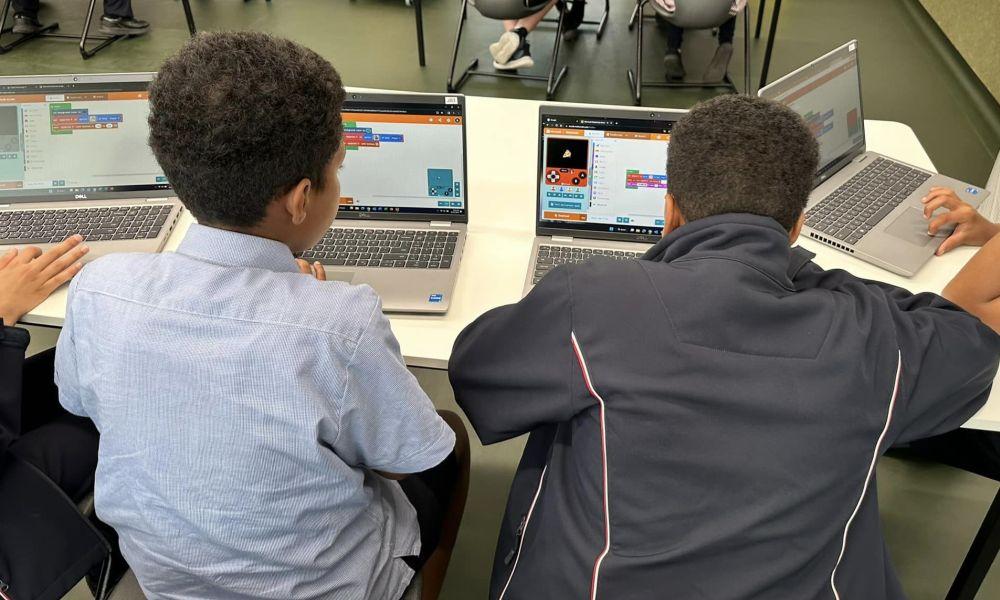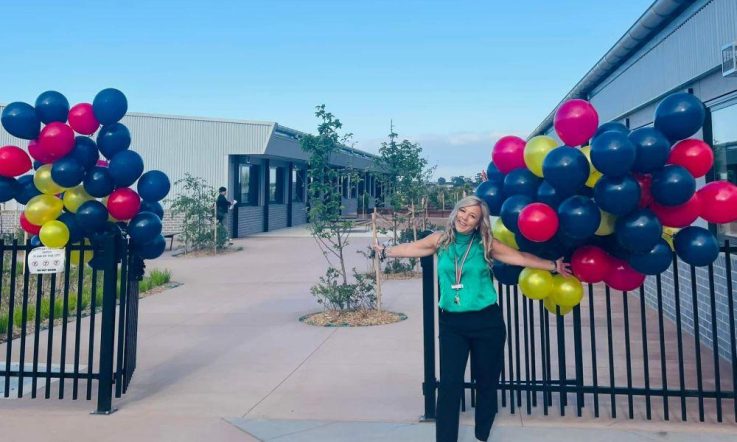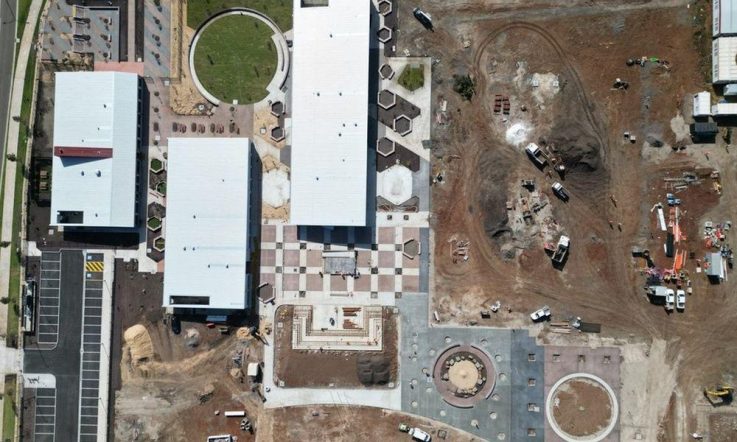Before we jump into this episode, are you subscribed yet to the free weekly Teacher bulletin? Get a weekly wrap of our latest content straight to your inbox. Join our community by clicking on the sign-up button at our website, teachermagazine.com.
Hello and thanks for downloading this podcast from Teacher, I’m Dominique Russell.
Welcome to the School Assembly podcast series, where we explore what it takes to build a school from the ground up. As regular listeners will know, Teacher Editor Jo Earp is our host for Series 2, but I’ve got the pleasure of joining you for episode 7 while Jo is on holidays. Like you, I’ve been following Jo Camozzato and the team at Bemin Secondary College so far in the series. It’s a new dual campus school in the Melbourne suburb of Truganina, and so far, we’ve spoken about all the work that was undergoing before the school opened to students, like recruitment, planning, and the build itself. In the last episode, we heard all about the exciting open day.
So, now the students are filling the classrooms and building relationships with staff and peers, important work is underway for setting the pathway for teaching and learning. So, in this episode, I’m going to pick Jo’s brain about the school’s instructional model. Let’s jump in.
Dominique Russell: Welcome, Jo, to Episode 7 in our series where we're going to delve into the instructional model at Bemin Secondary College and I’m really excited to get into the nitty gritty of that. But first, since our last episode with you, you did have the official opening of the school, and that looked like another really great celebration. So, how did all of that go?
Joanne Camozzato: Hi Dominique. Good morning to you as well. Look, the official opening of the school was a really special event. We aimed to walk all our year 7s over to the larger campus and we thought it would take about 45 minutes to walk 115 year 7s, because it's a kilometre-and-a-half, and we thought, you know, they'd be dragging their feet a little bit. But, in actual fact they literally sprinted. The teachers were out of breath, and they were there in about 15/20 minutes flat because I think they were so excited.
I was glad I made that decision – even though at the time I thought, oh, this is so much to just sort of try to get organised while everything was going on – because the younger students had an opportunity to walk around the larger campus and to see some of the, I suppose, the same facilities, but on a grander scale. And, also, to see that there are some sections of the main campus that still need to be built, whereas on their campus everything is finished, which is kind of exciting for them.
And then at the same time it was special, I think, for the senior students who had been sort of explained that all the younger students would be there, to see that they really do exist. And it was a special moment to see them all in the outdoor seating area near the flags and to bring the Minister of Education over (who currently in Victoria is Ben Carroll) and our local member (Sarah Connolly), to sort of, you know, present in front of the students.
And that was grand. There were lots of Department of Education people there as well and some of our colleagues from local schools. And certainly, the students who recognised a couple of the principals that were there were really excited to see their previous principal, like they felt very proud and went up to them and said, ‘oh, look, this is our uniform’. So, it was a great day.
And we had a fabulous cake that one of our staff members is into that wonderful cake making that I can't do, with terrific decorations, and she emblazed our logo onto the cake. And that was great too. We invited some of our student leaders to participate in that and then what was left, the staff ate later after school.
DR: Wonderful. They all deserve a piece of cake, don't they, after such a busy time. So, in this episode I do want to talk about the instructional model like I mentioned. So, as a principal or a leadership team, when you're looking at really setting that pathway for teaching, what are the things that you're looking for?
JC: I think for the instructional model, I mean it's a big topic and it's something that's going to take a while to sort of embed into a school. I like to mirror some of the research that has been presented by the Department of Education here in Victoria, because it's good research. So, they have many supporting documents to help us: high impact teaching strategies, principles of teaching and learning, the improvement cycle. There are many things that we can look at to use, but at the same time I'm confident when we refer to them because I also know they're referencing people like John Hattie, you know, [Robert] Marzano; key educators that have been very vocal and are still connected to universities, present in literature, they're embedded in these documents, so I think that's our starting point.
I know there are other models, there are all different models out there, but if you actually look at some core, key features; I think many of us have recognised that there needs to be core key features in every model in order to engage our students, and I suppose make sure we are also delivering responsibly an opportunity for students to improve.
And the other thing about an instructional model at a new school is that if you don't open with one, there's kind of a bit of, like, ‘what are we doing?’ And then when you do open with one, there is a danger of feeling that you're imposing something. So, there's a fine line. However, I'm going to say, after saying that we have opened with one because I feel, like everyone, teachers like structure. They need to know what the expectation is. Is this similar to what they used to? Is it a little bit different? Or can they see the joining points (‘yes, I know what this means, it's just slightly different language’) because otherwise it's kind of too loose.
So, in a way, I've sort of combined, I think, some things that we think are really important and we're being very explicit about it. So, there's a focused part of the lesson and in that beginning part of the lesson, the ready to learn routines need to be taught. Are you ready to learn? Is your brain being switched on or do you need to be doing a mindful activity? I mean that can all look different, and I think that's important too. And in that section, it is about the learning intentions. What are we actually doing today or for this week? And reminding students this is what our purpose is here, so there is some connection to why they're learning these items.
Embedded in that is exploring the learning cycles. So, what does that look like? There's applied learning, there's explicit teaching time, there's adjusting or differentiating the lesson, there's consolidating understanding, and then there's a choice of, you know, is there individual or collaborative learning going on? And then hopefully there's also some time at the end to reflect. Now whether you're reflecting back on success criteria or sharing learning, reviewing what's actually happened in the lesson, that's also, I suppose, in the hands of the teacher.
But I have put an approximate time around this. We have an hour session and some of our sessions are 2 hours. And people might go ‘oh my God’, but 2 hours is mainly in secondary for our practical subjects like Food, PE, Design Technology, Visual Arts – those kind of subjects have 2-hour blocks, everything else has one hour. But I’ve found in the past that if you don't suggest timing, you can find that teachers fall into the trap (and we all do it – I'm doing it right now! – where you talk nonstop for 25 minutes and half the lesson, you know, you're sort of kind of putting people into a trance because you're doing all the teacher talk). So, the minutes are there to guide people, guide people to say, ‘that's enough on that’, you know, ‘you need to move on’.
And with our model too, I'm very big into graphics. So, we have visualised our model. It's made up of segments and probably part of our work will be to explain that these segments can be shifted around and repeated. So yes, you can go in a linear fashion through this cycle, but you can also say, ‘I'm going to do that bit first, I'm going to do this bit second. I'm going to repeat this sort of sharing of learning during that hour at different points to make sure that I'm not just talking for 30 minutes’.
And as students get older, as we all are aware, there's a real danger with some of our curriculum to spend all our time doing the teacher talk.
DR: That was a fantastic summary of like you say, such a huge topic. I wondered if before we get into your work with the staff on this in terms of professional development and things like that, is there anything else to mention in terms of the philosophy at the school in regards to classroom instruction?
JC: Probably my biggest comment there – and it's a challenge, it's a challenge at every school that I've worked at – is we expect staff to differentiate. I was going to say I do, but so do some of the staff and the leaders that I've employed, which is why I've employed them.
To actually adjust the work according to student need is very important. And that makes it inclusive. I mean, this is the whole thing, it's about inclusivity. So, in order to differentiate, that's a high skill. Some people are very good at it; some people really struggle. And I often find, in the past, sometimes when teachers don't differentiate, it's because they lack the skill, and we have to teach them. And it takes a period of time to improve that area, and it may be that some people that they’re teaching with are better at it, so we draw on their skill set.
Differentiation is an interesting one because sometimes people go straight to the students who have more challenges, but I think we don't do enough talking around how do you differentiate to extend the students that are cruising along? I mean, we know Australia is known to be a little bit cruisy and that's probably something we really enjoy about our country and the sort of stereotype, little bit of laid-back attitude. But the reality is that yeah, we do have students cruising in classrooms. So, how do we differentiate? And that's probably the main message that I want to get across.
We’ll be back after this short break.
If you’re enjoying the Teacher podcast channel, have you subscribed yet to our free Teacher bulletin? It’s the best way to get all of our latest stories straight to your inbox. In addition to a weekly wrap up of our latest content, subscribers to the bulletin can receive Teacher Trending, where we share our top 5 pieces of content on a trending topic, and special editions where we share a bonus piece of content with you. The sign-up process is easy – just visit our website, teachermagazine.com and click on the sign-up button on the righthand side of our homepage.
DR: And so, when we talk about communicating that to staff, can you talk me through what that kind of looks like for you? Is it like I said, is it a lot of modelling or is it a lot of professional development? I imagine it's a bit of both.
JC: Yeah, it's a bit of both. And it's kind of a, I wouldn't say awkward question, but it's like we're just at the beginning, it's like week 5.
And I think what's important too, in the first few weeks or the first few months, is you have to get a temperature reading from your staff around where their skillset lies. Remember, we've only had the very simple interview at some point and reading their resumes and applications and having a few referee checks. That's all we know about staff. So, you're getting a temperature reading around staff, what they need. And what areas – I suppose in a way differentiating the professional learning and our school improvement meetings and our professional learning communities according to the need of staff. But that has to also match up or we also have to acknowledge we have to know our students quite well. So, what is it that they need and what is it that they're missing? And how does that marry up with the skillset of the staff?
And in new schools – and I'm finding this is probably a challenge so, you know, later on you can ask me what the hurdle is too – It is a fine line between being very logical and plan what needs to happen next, but also being very responsive and occasionally reactive. Because sometimes you can't just go, ‘oh, that’s OK’, you go ‘no I need to change that right now’. So, working with staff takes a long time to actually start to set up the expectations, and even though we've started that already, now we have to see how people respond to that.
And then, what professional learning? I have already sort of engaged some people for professional learning and I've already booked some staff in to do some things in areas that we want to grow, like professional learning communities, literacy coach, that kind of stuff. But it's not a simple, like we're just going to go ‘… … …’ and do this. It doesn't work like that. Well, I don't think it works like that, because you take the responsiveness out of the planning; but this makes a lot of people nervous.
DR: Is part of that really trying as much as you can to get into the classrooms with these teachers? You've got such a big school across 2 campuses and so many staff. So, is that realistic to be able to get in there as much as you can?
JC: No, it's completely unrealistic. OK, so I'm just going to be really blunt about that.
I mean, what I sort of do is do a quick whip around and get a temperature check on kids, how they're going, I have a look. Are they being compliant? Are they being engaged? So that's the other thing too. There is a difference. You can have wonderful students sitting there doing all the right things and writing and putting their hands up, but are they actually engaged? And you know, there are many classes I think the students are engaged, but I’m sort of trying to get a feel.
But it's not just about me, so this is where the school leaders are doing some of this. So, the learning specialists that I employed, one of their very first tasks was like, meet, go and observe, check in, in a very casual way, what's happening in these subject areas for the students. It's not about saying to staff ‘you're being coached’ or anything like that. We're not doing that. We're just actually wanting to see have the students got equipment? What's their writing skills like? Even by eyeballing their books. Are organised in the use of their devices? Can they actually use their laptop well? And, you know, have a chat to people in your subject area to see how things are going and what do they need and what are they finding challenging and what's working well? So that's the first part of the work we've done this first month really.
And one of my learning specialists, one of her extra briefs, is also to check in on graduate teachers and people who might have permission to teach or are paraprofessionals. And she's having one-on-one meetings, popping into the classroom in a very informal way. So, no official coaching has started. No one’s sitting down and making goals. It's really just ‘Here we are, what do you need? How are things going? What's challenging? Is the hour session good/bad? Is the double session good/bad?’ … I'm getting that feedback.
And the other thing is like a lot of primary schools and many schools around Australia, we only have an hour after lunch, and it's absolutely fantastic. So no longer will I ever be a secondary school that has more than one hour of instruction after lunch. I have really noticed that that's been a big change. But getting that feedback from staff that it is working well or not working well.
For me, it's not realistic for me to, you know, really spend too much time sitting in a classroom. But I'm also interested in talking to the students in the yard and seeing what they think and how they feel about things in order to sort of collect that evidence, if you like.
DR: We could talk about this for at least another hour, I'm sure, but I'll cut us off there and we'll get into the final questions that we ask at the end of every episode. So, tell me about your biggest hurdle, biggest achievement, and also key learning since we last spoke with you at the end of January.
JC: Look, I think the biggest hurdle is still for me (this is for me personally as the principal) managing my time across the 2 campuses. Last week I spent a lot of time at the senior campus. In fact, I didn't get to the junior campus at all. It was for a very brief amount of time, and I felt personally, really bad about that. Like, I felt like these kids haven't seen me walking around or popping into the classroom for 5 days, and I didn't like it.
But I have to accept it, that in these early stages there may be – if I'm responding, also, as well as managing a more structured approach – there may be times where I have to spend more time at the larger campus. However, I did go away, and maybe it's not so much a hurdle anymore, and we've developed a much more structured timetable for the principal team. I thought we were ready to do that now, halfway through the term. Enough of this running around from one campus to another. We put in blocks of time and we're all very clear, so there's a certain amount of people on each campus to support our teachers and students, and I'm starting to work to that now. So, I've got through that hurdle, and I've gone, ‘OK, that's enough of that. I'm going to go crazy doing that. Now I need to start to move across into a more structured approach’.
DR: And biggest achievement or key learning, or are they all wrapped up into one?
JC: Oh yeah, I think probably they're probably one. Look, I think sometimes, you know, I made a change to the timetable structure in the sense that – when I say structure at year 10, our student choice subjects (or our electives) all ended up landing on one day, because we were lining it up with students who are going to Wyndham Tech School to do their Gaming and E-sports elective and whole range of things. And it was very clear to us that Wednesday became party day/ elective day. And I thought, no, this is going to stop right now. So, students who enjoy the structure of the rest of the week were finding that day all too much. They were swapping out. They were, you know, starting to, if they didn't like it, ‘maybe I don't have to go’ and it was like ‘we're not continuing that’. So, I immediately sort of said, ‘well, we're changing it’. Everyone went ‘oh’ and I said, ‘well, no, I'm not waiting’.
And this is probably my learning. There are times where it is important to wait and see if something's working, and then there are other times, through my own experience, I know if I let that go, that's going to result in, you know, perhaps these student choice subjects that teachers have worked hard to create in response to student interests not work so well because we haven't got the structure of our week right. And so, we made an immediate change in the middle of the term. We told the teachers (we got a bit of feedback from teachers as well) but we informed the teachers, informed the students and already this week it was very different. Because there is something to look forward to that students might enjoy personally scattered through the week, not just on one day. And so, it was really a response to students, helping them regulate, but also helping them enjoy their whole week and that they do have different things to look forward to, not just their core subjects.
So, it was achievement, and it also was a learning that, don't be afraid at times to strike very quickly in order to stop things from becoming more complicated and negative, you know, when it was a really positive thing. So, it's gone back now, which is great.
DR: Well, I think that was definitely everything that we wanted to cover in today's episode, Jo, thank you so much for joining me.
JC: No worries, Dominique. My pleasure.
That’s all for this episode. Thanks for listening. We’ll be back again with the next episode of School Assembly next month. Don’t forget to subscribe to our podcast channel wherever you get your podcasts from so you can be notified of any new episodes as soon as they land.
Are you currently subscribed to the weekly Teacher bulletin? It’s a free weekly wrap up of our latest content straight to your inbox. Join our community by clicking on the sign-up button at our website, teachermagazine.com.
Other episodes in this series:
In this episode, Jo Camozzato discusses the importance of differentiating to extend students as well as support students.
As a school leader, in what ways are you supporting your staff to differentiate in their teaching? Are all staff confident in their skills in this area? Are they mindful of differentiating for all students, including those who would benefit from being extended in their learning?



